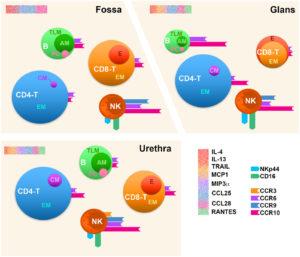The male genital tract is a portal of entry for many sexually transmitted infections (STIs). One of main strategies to reduce incidence of STIs is to develop vaccines that provide protection at the main site of entry. To achieve this we first need to understand the immunological environment of both the female and male genital tract. The human penis consists of four different regions: the foreskin, glans, fossa navicularis (referred as fossa) and urethra.
There is a great knowledge gap in the understanding of the penile immune system, beyond the foreskin. Researchers from France obtained penile samples from elective gender reassignment surgery, and performed in detailed phenotyping of, B T and NK cells in the fossa, glans and urethra.
Mucosal memory B cells were abundantly found in all regions of the penis and reached up to 75% of B cells in glans. Sennepin et al. observed large phenotypic diversity of memory B cells with preferential enrichment of certain phenotypes depending on penile site. For example, they observed that activated memory B cells represented 30% of all B cells in the urethra compared to only 15% in the glans. Activated memory B cells differentiate into plasma cells, cells responsible for antibody secretion, thus can be a major target for vaccine induced immunity. Additionally, researchers identified high expression of CCL20/MIP-3α in the urethra and CCL28 in all penile tissues. This suggests that homing to the urethra and all penile organs is mediated by CCR6 and CCR10, respectively.
With regard to the T cell compartment, Sennepin et al. observed that CD4 T cells represent half of all T cells in the penile region, in contrast to the female genital tract. Effector memory cells represented the most dominant CD4 and CD8 T cell memory phenotype, suggesting active continuous immunological monitoring of penile tissue as they also expressed CCR6 and CCR10. Majority of NK cells detected were CD16+CD56dim with high expression of NKp44, suggestive of cytotoxic function with the ability to produce IL-17 and IL-22 cytokines.
This study provided an in depth immunological characterisation of the penile organ, which illustrated phenotypic and functional B and T cell diversity, in different regions of the penile organ. Information generated from this study can inform targets of preventative vaccine strategies against STIs.
Journal Article: Sennepin et al. 2017. The Human Penis Is a Genuine Immunological Effector Site. Frontiers in Immunology.
Article by Cheleka AM Mpande












